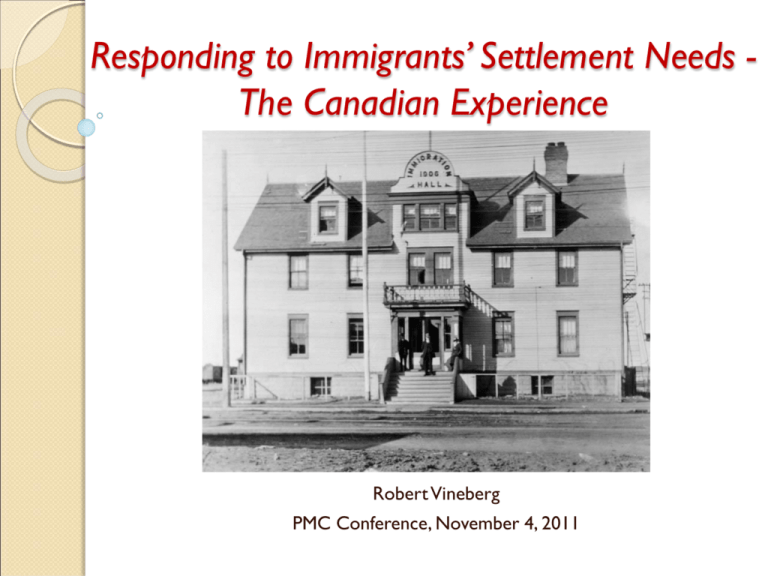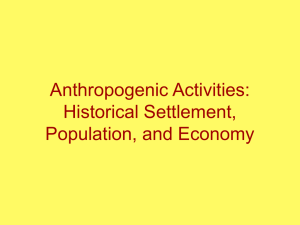Responding to Immigrants' Settlement Needs
advertisement

Responding to Immigrants’ Settlement Needs The Canadian Experience Robert Vineberg PMC Conference, November 4, 2011 Contents Pre-Confederation Post-Confederation to 1914 The Interwar Period Post World War II to 1974 Creation of the Settlement Program Settlement Renewal and Devolution Funding Issues Modern Settlement Programming 2 The Two Way Street I can scarcely imagine any obligation which it is more incumbent on Government to fulfill, than that of … securing to … persons disposed to emigrate every possible facility and assistance, from the moment of their intending to leave … to that of their comfortable establishment… Lord Durham, 1839 3 Pre-Confederation Early Legislation Protect the emigrant, protect yourself ◦ Quarantine Acts NS – 1761; Lower Canada - 1795 ◦ Legislation for a landing fee – 1832 All provinces raised money for the sick and destitute Emigrant Aid Societies 1858 Province of Canada Legislation First legislation to specifically concerned with immigrants own welfare 4 Grosse Ile Quarantine Station Second Class Hotel 5 Post-Confederation – To WW I Sorting Out Jurisdictions ◦ Dominion-Provincial Conference 1868 Dominion takes control of quarantine stations Dominion undertakes to prepare national legislation: immigrants not emigrants Looking After Immigrants Port of Entry Facilities Immigration Halls Dominion Lands Act Grants to many immigrant aid organizations 6 Quebec Port of Entry c.1890 7 Immigration Hall Winnipeg c. 1890 8 Post-Confederation – Interwar Period The 1920s ◦ Emphasis on Colonization Homesteading continues ◦ Railways Agreements “After Care” ◦ Empire Settlement Agreement ◦ Immigration Halls continue in large-scale use Depression and War Immigration comes to a halt Many immigration halls used for unemployed and then as army barracks during WW II 9 Immigration Hall No. 1 Winnipeg – 1906-1969 10 Post World War II to 1974 Settlement Service established 1949 ◦ focused on employment and matching immigrants overseas to jobs in Canada Citizenship Branch ◦ funds language training and joint co-ordinating committees in many cities 1966: Manpower & Immigration Settlement Service disbanded and programs transferred to Manpower division & Secretary of State Language training only for workers 11 The Settlement Program - 1 ◦ 1974 – Cabinet realises mistake of 1966 and creates “Settlement Program” M&I assumes funding for settlement NGOs. 1974 - ISAP program $810,000 ◦ Indochinese Refugee Movement: Inspires government to rethink settlement Vastly increased need for NGOs and funding 1984 - HOST program ◦ 1986 - Settlement Language Training Program (SLTP) for adults not destined to labour market 12 The Settlement Program - 2 1992 – Settlement “comes home” Settlement moved to Immigration Division Occupational language merged with SLTP to create LINC 1991-1999 – Some provinces assume responsibility for settlement 1991 Quebec 1999 BC and Manitoba New Programming 13 The Settlement Program - 3 2004-07 New Programming Canadian Orientation Abroad - 1998 Enhanced Language Training – 2004 Anti-Racism - 2005 Foreign Credential Referral Office- 2007 Canadian Immigrant Integration Program - 2007 2005-08 – Vastly increased funding Canada-Ontario Agreement Expectations in other provinces first denied but then met 2008 – New Terms and Conditions unified Settlement program 14 A Few Conclusions Settlement Services Initiated to protect the resident Canadians Then transformed into efforts to retain immigrants coming to Canada Integration is a two-way street The best settlement program will fail in the absence of a welcoming community. This is a lesson that Canada has learned, and then forgotten, only to rediscover again, several times through its history. Settlement and integration are ‘whole of government’ activities NGOs are essential to program delivery 15 Former Immigration Hall Edmonton 2010 16 Photo Credits Cover: Old Immigration Hall, Edmonton, Library and Archives of Canada (LAC) – C042729 Slide 5: Grosse Isle 2nd Class Hospital c1905 – LAC - c079029 Slide 7: Immigration Sheds at Port of Quebec– LAC – a021357 Slide 8: Winnipeg Immigration Hall c1890 – LAC – c2334 Slide 10: Immigration Hall No. 1 Winnipeg, (Dominion Immigration Hall), Archives of Manitoba - N21668 Slide 16: Edmonton Immigration Hall 1931-1971, Frank Dumont – CIC Edmonton 17







